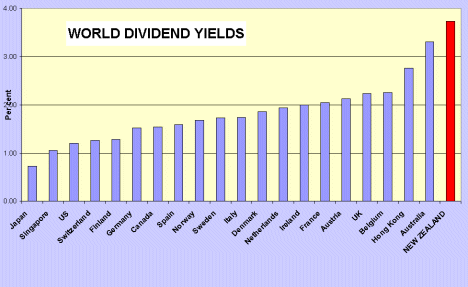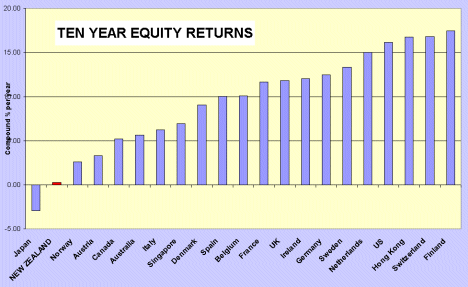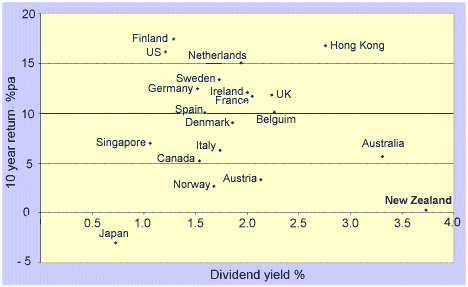Research: New Zealand’s high dividend yields – what’s going on?
New Zealand’s equity market offers an unusually high income yield. Is this to offer investors compensation for a relatively poor performance in terms of capital return? Or if not, what else might be behind it?
Saturday, January 8th 2000, 12:00AM
 One of the more distinctive features of the New Zealand equity market is its unusually high dividend yield. The chart below shows the gross dividend yield from the New Zealand market and from 20 other developed country equity markets, and shows New Zealand with the developed world’s highest yield. The data are sourced from the FT/S&P Actuaries World Indices in June ‘99 – not that the exact date matters much, as this has been a long standing phenomenon.
One of the more distinctive features of the New Zealand equity market is its unusually high dividend yield. The chart below shows the gross dividend yield from the New Zealand market and from 20 other developed country equity markets, and shows New Zealand with the developed world’s highest yield. The data are sourced from the FT/S&P Actuaries World Indices in June ‘99 – not that the exact date matters much, as this has been a long standing phenomenon.

One possible explanation is a high level of income is required to attract investors into a market which by international standards has offered one of the worse total returns over the past decade, as the following chart shows. For the same set of countries as in the income chart, it shows the average annual return, in US$, over the ten years to June 1999; the data are the MSCI single country indices.

New Zealand’s ranking amongst the developed economies’ equity markets is poor. As at June, only the Japanese market had produced worse US$ returns over the past decade, and if (as is plausible at this point) the Japanese market continues to rise in anticipation of economic recovery, then New Zealand risks relegation to the wooden spoon position. So we seem to have a clear association – a very high dividend yield, a very low total return.
A possible link?
An economist’s possible explanation, generalising from this New Zealand example, might be that investors could be expected to accept a lower dividend stream from high return markets but demand a higher dividend stream from poorer return markets. If you are earning high capital returns, for instance, the absence of an income stream may not matter – as seemed to be the case for investors in the Japanese equity market in the 1980s and may well be the case for Internet stocks in the US today. New Zealand equity market commentators have made this argument, too, noting that the benchmark equity index (the SE40) understates the return to investors because it is a capital index and does not count the high dividend stream.
But that explanation does not appear to hold any power at all. The next chart shows a plot of total returns over the past decade, compared with current dividend yields. And while you might expect some inverse relationship, there is absolutely none. There is certainly none visible to the eye, and if you run a quick quantitative test (a simple regression of one on the other), there is no statistical link detectable, either.
Now, there are all sorts of reasons why there appears to be no link between current dividend yields and past total returns. It could be, for example, that investors do not regard past returns as a good proxy for expected future returns. There may be local tax factors where, for example, investors in one jurisdiction may prefer capital gains to income (or the other way round). But in any event a simple, neat explanation of New Zealand’s high dividend yields does not emerge from this analysis.

All of which suggests that there may be some local explanation for what is going on, rather than some systematic pattern happening across world equity markets. And it is interesting to note that New Zealand’s nearest neighbour on the scatter chart is Australia – suggestive of something specific to Australia and New Zealand that is not shared more widely. What might it be?
Some possible explanations
At least in New Zealand’s case, the unusually high dividend yields seem to me to reflect five factors:
- Low rates of personal savings and, within that low savings pattern, a low proportion of savings flowing into financial assets.
- The wariness of the personal saver post –1987.
- The high returns available from fixed interest investments.
- The current ‘short-termism’ of New Zealand markets.
- Scepticism over economic recovery.
- Tax.
These are well-known local facts requiring little further explanation. It’s a simple supply and demand situation – a lower supply of funds raises the return on those funds. And nothing much has changed on this front. There is plenty of evidence, for example, that the big bonus to many families’ incomes from dramatically lower mortgage interest rates has flowed straight into the shops, and not been saved (despite the excellent savings campaign on television by the Retirement Commissioner).
This at first blush may seem like ancient history – most OECD markets have moved on both in terms of share prices and investor psychology from the 1987 crash. Not so in New Zealand. The market is still trading at only 50-60% of its (admittedly absurdly over-inflated) 1987 peak value, and investors continue to be wary of the market for further reasons. These reasons include insider misbehaviour, continuing inadequate disclosure of intended corporate strategy and performance, and the vulnerability of minority investors in companies where there is an investor with a controlling stake (a common situation in the New Zealand market). Investors, in short, could well be demanding (and getting) a risk premium for wading into muddy waters.
At the risk of wandering into microeconomics, I would also not be surprised if some listed companies were using dividends as a signalling device of their probity when probity itself cannot be directly observed. They demonstrate their willingness to fulfil their implicit fiduciary contract with the investor by showing they can and do fulfil an explicit monetary contract by way of dividends.
The argument here is that the equity market has had to offer an income stream that is competitive with the returns available virtually risk-free in the fixed interest and money markets. Even today, with inflation very low and inflationary expectations well beaten down, relatively high returns persist on fixed interest and bank deposits. The yield on the benchmark 10 year Government bond is over 7% - and this in an economy where inflation over the next year is expected to be only 2 to 2 1/2 per cent.
This is a harder hypothesis to prove but there is a fair degree of qualitative evidence that the horizon of most economic actors in New Zealand is short. Current examples would include underinvestment in key infrastructure by local and central government; "restructure of the month" behaviour in the corporate sector; companies overweighting defensive cost reduction strategies as against growth and investment strategies; the ongoing inability to forge a long-term agreement on national superannuation policy; and the tactical drift of government policy from one situation to the next (perhaps to be expected in this election year). In this climate you might well expect investors also to be looking for bread today (dividends) not jam tomorrow (capital growth).
In all likelihood quite a few investors are still sidelined because they have not caught up with the state of the economic cycle, or don’t trust themselves to believe it. There has been a fair degree of scepticism about the state of the economy in the compulsively downbeat NZ media, especially in the light of the surprise downturn in June quarter GDP – not helped by a number of the opposition parties using the election campaign to harp on about "fifteen years of failed policies". Again, any investor braving the equity market in this frame of mind may well be responding to income on offer, and discounting growth.
Whenever there is an apparent anomaly in the financial markets, it is always a good idea to ask whether the tax system has anything to do with it. In New Zealand the typical ‘active’ fund manager will be paying income tax on capital gains, but will not be paying income tax on fully imputed dividend income received. So fund manager (and individual investor) preferences will in all likelihood be transmitted one way or another to corporate CFOs. This might also go some way towards explaining why Australia – which also has a dividend imputation system – offers the next highest dividend yield to New Zealand among developed markets. The higher dividend yield in New Zealand could well be explained by its more brutal treatment of capital gains.
Where to from here?
It is reasonable to expect some of the reasons that currently underpin high New Zealand dividend yields to lose their force over time. In particular, the relatively high real rates of return still available in the money and bond markets will gradually continue to fall, as the "low inflation is here to stay" mindset finally replaces the last lingering memories of New Zealand’s high inflation history. In the shorter term, though, the Reserve Bank’s current tightening cycle will see still higher yields on offer before they descend into low-inflation nirvana. And the accumulating evidence of faster growth and improving corporate profitability will also play its part. Clearly, though, some of the reasons are rather more structural and persistent (notably, the tax system).
The upshot is that it is reasonable to expect New Zealand’s high dividend yields to decline somewhat from current levels, but to remain towards the high end of the international spectrum.
In turn (with one major proviso) this suggests that there is a window of opportunity for managers of income-oriented funds (equity income funds and multi-sector diversified income funds), where selective addition of New Zealand equities could give a useful boost to the portfolio’s overall dividend stream.
The one major proviso, of course, is the capital growth foregone by investing in the New Zealand market compared with just about any other market ex Japan – if the last decade’s performance is any guide. At this point let’s just say that some of the factors that have weighed on the New Zealand equity market are improving, in particular the traumatic impact of economic restructuring over the 1984-92 period, and the loss of value caused by some errant major equities (most spectacularly, Brierley). That is certainly the viewpoint of some of the US fund managers I visited in the US in September and October – though I suspect they do not want to wait many more quarters for the recovery that they feel has remained just over the horizon for long enough already.
Donal Curtin is Managing Director of Economics New Zealand.
| « Which star signs are the best savers in the Zodiac? | King builds an empire » |
Special Offers
Commenting is closed
| Printable version | Email to a friend |









